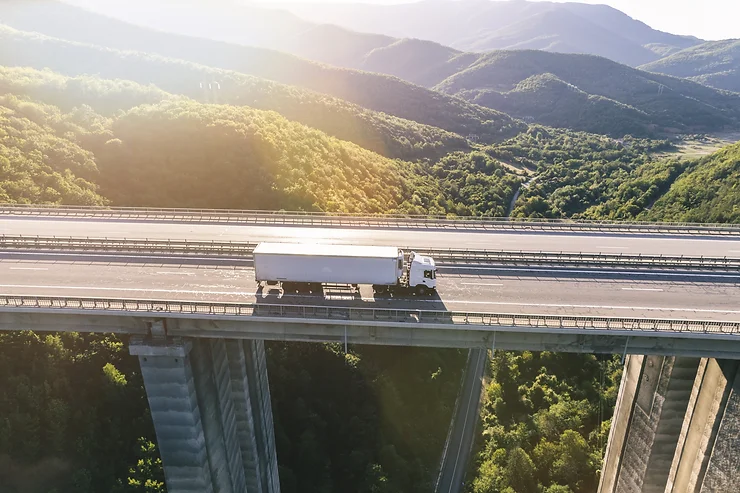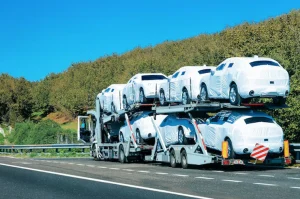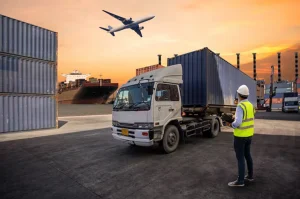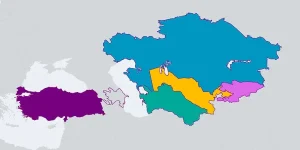Land transportation from Central Asia to Europe is a vital component of international logistics.
Land transportation from Europe to Central Asia is possible through several routes, but the specific route you choose may depend on your starting point in Europe and your destination in Central Asia. Central Asia includes countries like Kazakhstan, Uzbekistan, Turkmenistan, Kyrgyzstan, and Tajikistan. Here are some common land transportation options:
1. Road Transport:
-
Eurasian Highway: This is a network of roads and highways that connects Western Europe to China through Central Asia. It includes the E60, E30, and other European routes. The journey typically involves crossing multiple borders and may require permits and visas for each country.
-
Trans-Siberian Highway: This is a route that goes through Russia and connects Europe to Central Asia. It passes through Kazakhstan and can be an alternative to the more southern routes through countries like Turkey and Iran.
2. Rail Transport:
-
China-Europe Railway: Although this is primarily a rail connection between China and Europe, it passes through Central Asian countries like Kazakhstan and can be used for transporting goods between Europe and Central Asia.
3. Combination of Road and Rail:
-
You can use a combination of road and rail transport to reach your destination. For example, you might take a train to a major city in Central Asia and then use road transport to reach more remote areas.
Land Transportation from Europe to Central Asia: Pros & Cons
Land transportation from Europe to Central Asia offers both advantages and disadvantages. The choice of transportation method should be based on your specific needs, budget, cargo type, and time constraints. Here are some pros and cons of land transportation to Central Asia from Europe:
Pros:
-
Cost-Efficient: Land transportation can often be more cost-effective than airfreight, especially for bulky or heavy cargo. It allows for the transportation of larger quantities of goods at a lower cost per unit.
-
Versatility: Land transportation offers versatility in terms of the types of goods that can be transported. It can accommodate a wide range of cargo, including perishable goods, machinery and equipment.
-
Reliability: Compared to sea transportation, land transportation tends to have shorter transit times and more predictable schedules. This can be crucial when you need to meet tight delivery deadlines.
-
Accessibility: Land routes can provide access to landlocked Central Asian countries, such as Kazakhstan and Uzbekistan, which may not have direct access to sea ports. Road and rail networks can extend deeper into these regions.
-
Control Over Cargo: Land transportation gives you more control over your cargo throughout the journey. You can monitor its progress and make adjustments if needed.
-
Easier Communication: Land transportation allows for easier communication and coordination with transportation companies and local authorities along the route compared to complex international shipping logistics.
Cons:
-
Distance and Time: Land transportation between Europe and Central Asia can be time-consuming, especially for long distances. It may take several weeks to reach your destination, which may not be suitable for time-sensitive shipments.
-
Infrastructure Challenges: Some parts of the road and rail infrastructure in Central Asia may be poorly maintained, leading to delays and potential damage to goods. Infrastructure quality can vary significantly along the route.
-
Border Crossings and Customs: Crossing international borders can be a complex and time-consuming process, involving paperwork, inspections, and potential delays. Different countries may have varying regulations and requirements.
-
Security and Safety: Some regions along land routes may have security concerns due to political instability or conflicts. It’s essential to stay updated on security conditions and take appropriate precautions.
-
Environmental Impact: Land transportation can have a higher environmental impact compared to sea or rail transportation. It often involves the use of fossil fuels, contributing to greenhouse gas emissions.
-
Cost Fluctuations: Fuel prices, tolls, and customs duties can fluctuate along the route, affecting the overall cost of land transportation. These cost variations can be challenging to predict.
-
Limited Accessibility: While land transportation is versatile, it may not be suitable for destinations in extremely remote or challenging terrain. In such cases, alternative transportation methods may be necessary.
Land Transportation to Kazakhstan
Land transportation to Kazakhstan, a Central Asian country with vast territory, can be achieved through various routes and modes of transportation, including road and rail. The choice of transportation method will depend on factors such as your starting location, destination in Kazakhstan, the type of cargo, and your specific logistical needs. Here’s an overview of land transportation options to Kazakhstan:
1. Road Transportation:
-
Trucking: Road transportation by truck is a common method for shipping goods to Kazakhstan from neighboring countries. You can use international trucking companies to transport goods by road. Popular routes include those from Russia, China, and Europe.
-
Border Crossings: Be prepared for border crossings and customs procedures when using road transportation. Ensure that you have all the necessary permits, visas, and documentation for your cargo and vehicles.
-
Infrastructure: While major highways and roads in Kazakhstan are generally well-maintained, conditions may vary in rural or less-developed areas. Plan your route carefully, considering road conditions and distances.
-
Time and Distance: Road transportation can take time, especially if your destination is far from the border. Be prepared for long journeys if shipping goods to remote parts of Kazakhstan.
2. Rail Transportation:
-
Railway Networks: Kazakhstan has an extensive railway network, and rail transportation can be an efficient option for transporting goods, especially bulk cargo.
-
Container Trains: Container trains, such as those along the China-Kazakhstan-Europe route, offer a cost-effective and reliable way to transport goods in containers.
-
Customs and Documentation: Similar to road transportation, rail shipments require compliance with customs regulations and documentation.
3. Combined Road and Rail Transport:
-
Depending on your cargo and destination, you may use a combination of road and rail transport to reach different parts of Kazakhstan efficiently.
4. Border Regulations and Documentation:
-
Kazakhstan, like many countries, has specific regulations for the transportation of goods across its borders. Familiarize yourself with these regulations and ensure all necessary permits and paperwork are in order.
5. Weather Considerations:
-
Be mindful of weather conditions, particularly during the winter months when road and rail transportation may be affected by snow and ice.
6. Distance and Transit Time:
-
Kazakhstan is a vast country, so the transit time from the border to your final destination within the country can be significant. Plan your logistics and schedules accordingly.
Land Transportation to Uzbekistan
Land transportation to Uzbekistan, a landlocked country in Central Asia, is possible through road and rail networks. Uzbekistan has a well-developed transportation infrastructure that connects it to neighboring countries and allows for the movement of goods. Here’s an overview of land transportation options to Uzbekistan:
1. Road Transportation:
-
Trucking: Road transportation by truck is a common and versatile method for shipping goods to Uzbekistan from neighboring countries. International trucking companies offer services for transporting cargo by road.
-
Routes: There are several road routes into Uzbekistan, including from Kazakhstan, Kyrgyzstan, Tajikistan, Turkmenistan, and Afghanistan. The choice of route depends on your starting location and cargo type.
-
Border Crossings: Prepare for border crossings and customs procedures when using road transportation. Ensure you have all the necessary permits, visas, and documentation for your cargo and vehicles.
-
Infrastructure: Uzbekistan has a network of well-maintained highways and roads, but conditions may vary in rural or less-developed areas. Plan your route carefully, considering road conditions and distances.
-
Time and Distance: Road transportation can take time, especially if your destination in Uzbekistan is far from the border. Be prepared for long journeys if shipping goods to remote parts of the country.
2. Rail Transportation:
-
Railway Networks: Uzbekistan has an extensive railway network that connects to neighboring countries, including Kazakhstan, Turkmenistan, and Tajikistan. Rail transportation can be an efficient option for bulk cargo or containerized goods.
-
Container Trains: Containerized rail transport is commonly used for goods traveling long distances to Uzbekistan. It offers reliability and cost-effectiveness.
-
Customs and Documentation: As with road transportation, rail shipments require compliance with customs regulations and documentation.
3. Combined Road and Rail Transport:
-
Depending on your cargo type and destination within Uzbekistan, you may choose to use a combination of road and rail transport to optimize efficiency.
4. Border Regulations and Documentation:
-
Familiarize yourself with Uzbekistan’s border regulations and customs requirements. Ensure all permits and paperwork are in order to prevent delays at border crossings.
5. Weather Considerations:
-
Consider weather conditions, especially during the winter months when road and rail transportation may be affected by snow and ice.
6. Distance and Transit Time:
-
Uzbekistan is a large country, and transit times within the country can be significant. Plan your logistics and schedules accordingly.
Land Transportation to Tajikistan
Land transportation to Tajikistan, a landlocked country in Central Asia with mountainous terrain, can be challenging but is possible through road and rail networks. Tajikistan shares borders with Afghanistan, Uzbekistan, Kyrgyzstan, and China. Here’s an overview of land transportation options to Tajikistan:
1. Road Transportation:
-
Trucking: Road transportation by truck is one of the primary methods for shipping goods to Tajikistan from neighboring countries. International trucking companies provide services for cargo transportation by road.
-
Routes: There are several road routes into Tajikistan, including from Uzbekistan, Kyrgyzstan, Afghanistan, and China. The choice of route depends on your starting location and cargo type.
-
Border Crossings: Be prepared for border crossings and customs procedures when using road transportation. Ensure you have all the necessary permits, visas, and documentation for your cargo and vehicles.
-
Terrain Challenges: Tajikistan’s mountainous terrain can pose challenges for road transportation. Some routes involve steep and winding mountain roads, which may require specialized vehicles and experienced drivers.
-
Infrastructure: The road infrastructure in Tajikistan varies, with major highways connecting key cities and regions. However, conditions can be less developed in remote areas.
-
Time and Distance: Road transportation to Tajikistan can be time-consuming, especially if your destination is in a remote or mountainous area. Be prepared for longer transit times.
2. Rail Transportation:
-
Railway Networks: Tajikistan has a limited rail network, and rail transportation is less commonly used for cargo compared to road transport. However, rail transport can be suitable for certain types of goods and connections to neighboring countries.
-
Customs and Documentation: Like road transportation, rail shipments require compliance with customs regulations and documentation.
3. Combined Road and Rail Transport:
-
Depending on your cargo type and destination within Tajikistan, you may choose to use a combination of road and rail transport to optimize efficiency.
4. Border Regulations and Documentation:
-
Familiarize yourself with Tajikistan’s border regulations and customs requirements. Ensure all permits and paperwork are in order to prevent delays at border crossings.
5. Weather Considerations:
-
Consider weather conditions, especially during the winter months when road and rail transportation may be affected by snow and ice, particularly in mountainous regions.
6. Distance and Transit Time:
-
Tajikistan’s challenging geography can lead to longer transit times within the country. Plan your logistics and schedules accordingly.
Land Transportation to Kyrgyzstan
Land transportation to Kyrgyzstan, a mountainous and landlocked country in Central Asia, is primarily facilitated through road and rail networks. Kyrgyzstan shares borders with Kazakhstan, Uzbekistan, Tajikistan, and China. Here’s an overview of land transportation options to Kyrgyzstan:
1. Road Transportation:
-
Trucking: Road transportation by truck is one of the primary methods for shipping goods to Kyrgyzstan from neighboring countries. International trucking companies offer services for cargo transportation by road.
-
Routes: There are several road routes into Kyrgyzstan, including from Kazakhstan, Uzbekistan, Tajikistan, and China. The choice of route depends on your starting location, cargo type, and the condition of the roads.
-
Border Crossings: Be prepared for border crossings and customs procedures when using road transportation. Ensure you have all the necessary permits, visas, and documentation for your cargo and vehicles.
-
Mountainous Terrain: Kyrgyzstan’s mountainous terrain, including the Tien Shan Mountains, can pose challenges for road transportation. Some routes may involve steep and winding mountain roads, which may require specialized vehicles and experienced drivers.
-
Infrastructure: While there are major highways connecting key cities and regions, road conditions can vary, especially in rural or remote areas.
-
Time and Distance: Road transportation to Kyrgyzstan can be time-consuming, especially if your destination is in a remote or mountainous area. Be prepared for longer transit times.
2. Rail Transportation:
-
Railway Networks: Kyrgyzstan has a limited rail network, and rail transportation is less commonly used for cargo compared to road transport. However, rail transport can be suitable for certain types of goods and connections to neighboring countries.
-
Customs and Documentation: Like road transportation, rail shipments require compliance with customs regulations and documentation.
3. Combined Road and Rail Transport:
-
Depending on your cargo type and destination within Kyrgyzstan, you may choose to use a combination of road and rail transport to optimize efficiency.
4. Border Regulations and Documentation:
-
Familiarize yourself with Kyrgyzstan’s border regulations and customs requirements. Ensure all permits and paperwork are in order to prevent delays at border crossings.
5. Weather Considerations:
-
Consider weather conditions, especially during the winter months when road and rail transportation may be affected by snow and ice, particularly in mountainous regions.
6. Distance and Transit Time:
-
Kyrgyzstan’s mountainous terrain can lead to longer transit times within the country. Plan your logistics and schedules accordingly.
Land Transportation to Turkmenistan
Land transportation to Turkmenistan, a country located in Central Asia with a portion of its territory bordering the Caspian Sea, is primarily facilitated through road and rail networks. Turkmenistan shares borders with Kazakhstan, Uzbekistan, Afghanistan, and Iran. Here’s an overview of land transportation options to Turkmenistan:
1. Road Transportation:
-
Trucking: Road transportation by truck is a common method for shipping goods to Turkmenistan from neighboring countries. International trucking companies offer services for cargo transportation by road.
-
Routes: There are several road routes into Turkmenistan, including from Kazakhstan, Uzbekistan, Afghanistan, and Iran. The choice of route depends on your starting location, cargo type, and the condition of the roads.
-
Border Crossings: Be prepared for border crossings and customs procedures when using road transportation. Ensure you have all the necessary permits, visas, and documentation for your cargo and vehicles.
-
Infrastructure: Turkmenistan has well-maintained highways connecting key cities and regions, but road conditions can vary in rural or less-developed areas.
-
Time and Distance: Road transportation to Turkmenistan can be time-consuming, especially if your destination is in a remote area. Be prepared for longer transit times, and consider the distance you need to cover within the country.
2. Rail Transportation:
-
Railway Networks: Turkmenistan has an extensive rail network, and rail transportation can be an efficient option for cargo, especially bulk goods. The Trans-Caspian Railway connects Turkmenistan to Kazakhstan and other Central Asian countries.
-
Customs and Documentation: Like road transportation, rail shipments require compliance with customs regulations and documentation.
3. Combined Road and Rail Transport:
-
Depending on your cargo type and destination within Turkmenistan, you may choose to use a combination of road and rail transport to optimize efficiency.
4. Border Regulations and Documentation:
-
Familiarize yourself with Turkmenistan’s border regulations and customs requirements. Ensure all permits and paperwork are in order to prevent delays at border crossings.
5. Weather Considerations:
-
Consider weather conditions, especially during extreme temperatures in the desert regions of Turkmenistan. Plan for potential challenges related to weather conditions.
Georgia’s role in land transportation from Europe to Central Asia
Georgia plays a significant role in land transportation from Europe to Central Asia due to its strategic location at the crossroads of Europe and Asia. Its unique geographic position, well-developed infrastructure, and efficient logistics services have made it a crucial transit hub for cargo moving between these two regions. Here’s how Georgia contributes to land transportation from Europe to Central Asia:
-
Geographic Location: Georgia serves as a natural bridge between Europe and Central Asia. It is situated in the South Caucasus region, providing a land route that connects the Black Sea to the Caspian Sea and beyond. This location offers a shorter and more direct path for goods traveling between Europe and Central Asia.
-
Transport Infrastructure: Georgia has invested in modernizing its transport infrastructure, including roads, railways, and ports. The East-West Highway, running from the Black Sea port of Batumi to the Caspian Sea port of Baku in Azerbaijan, is a crucial part of this infrastructure. It facilitates the movement of goods across the South Caucasus.
-
Ports: Georgia has several ports along its Black Sea coast, with the ports of Batumi and Poti being the most significant. These ports provide easy access for cargo coming from Europe and enable efficient transshipment to Central Asian countries, particularly Azerbaijan, Kazakhstan, and Turkmenistan.
-
Customs and Border Efficiency: Georgia has taken steps to streamline customs procedures and border crossings, making it easier for goods to transit through the country. Simplified customs procedures and reduced bureaucracy contribute to faster transit times.
-
Free Trade Agreements: Georgia has signed various free trade agreements, including with Central Asian countries like Kazakhstan and Uzbekistan. These agreements can reduce trade barriers and tariffs, promoting trade and transit.
-
Logistics Services: The country has developed a robust logistics sector that offers a wide range of services, including warehousing, transportation, and customs clearance. Many international logistics companies have established a presence in Georgia to facilitate land transportation.
-
Rail Connections: Georgia is part of the Trans-Caspian International Transport Route (TITR), which connects Europe to Central Asia via rail. The Baku-Tbilisi-Kars railway is a key component of this route, linking Azerbaijan, Georgia, and Turkey and providing an alternative to maritime transportation.
The Importance of International Logistics
Central Asia as a Key Hub
Central Asia serves as a pivotal hub in international logistics, connecting the East and the West. Its strategic location makes it a prime starting point for cargo destined for Europe.
Connecting Central Asia to Europe
Toptrans specializes in facilitating this vital connection, ensuring that your cargo reaches Europe seamlessly. Our years of experience and expertise in international logistics set us apart.
The Role of Toptrans in Land Transportation
Reliable and Comprehensive Services
Toptrans offers a comprehensive range of services, covering land, sea, air, and rail transportation. We take pride in being a one-stop solution for all your transportation needs.
Expertise in International Cargo Transportation
With seven years in the industry, our team excels in handling various cargo types, including dangerous and military shipments. Your cargo is safe in our hands.
Diverse Fleet for Varied Cargo Types
Our diverse fleet ensures that we can transport goods of all shapes and sizes. We adapt to your cargo’s unique requirements.
Toptrans: Your Trusted Partner
Geopolitical Developments and Alternative Solutions
Amidst geopolitical developments, Toptrans has emerged as a preferred choice for partners seeking alternative transport solutions. We adapt to changing circumstances.
Our Client-Centric Approach
We prioritize our clients’ needs and satisfaction. Our customer service team is always ready to assist. Ask us anything or request a quote quickly!








